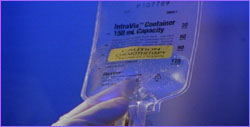
|

|
Designing Clinical Trials
Part 2 |
Back to Part 1
Watching and waiting
Folkman was delighted that clinical trials had finally begun
for the antiangiogenesis drugs, and he was optimistic about
their long-term promise. But he knew exactly what to worry
about. Most central was the simple possibility that the
human body might metabolize the drug differently than the
mouse body, rendering it impotent. That's what he'd had in
mind when he'd quipped to Times reporter Gina Kolata
that if you were a mouse with cancer, he could take good
care of you.
The clinical trials, meanwhile, were out of his control. He
was just an intensely interested observer. So he worried
about how they were being run and how they were being
perceived. Someone might give the wrong doses and derail the
trials. Or people wouldn't truly understand the process,
especially with a new kind of drug like endostatin, which
needed time and patience. Some of these drugs—whether
those developed by his lab or by others—might fail, he
thought, perhaps leading some people to doubt his entire
premise. "It's the same as the Challenger space
shuttle," he told people. "Challenger crashed because
of a frozen O-ring. But that does not overturn Newton's
principles. Some drug failures are the result of bad
O-rings."
|
 The clinical trials were run by others; all Dr.
Folkman could do was await the results.
The clinical trials were run by others; all Dr.
Folkman could do was await the results.
|
The clinical researchers worked hard to learn all they could
from the first patients. In all three centers, the patients
were tested almost incessantly with MRI scans, blood tests,
positron-emission topography (PET) scans, and a battery of
other diagnostic measures meant to watch for signs of damage
to their vital organs. It seemed to evoke the experience of
astronauts setting out on a dangerous test flight.
For some of the patients who found their way up Binney
Street in Boston to get their daily endostatin infusions,
the hardest part was the loneliness. Some patients had come
from as far across the country as Alaska, leaving family and
friends—all their support—behind. And when they
realized that the low doses were unlikely to cure them, some
gradually began to lose hope and concluded that the
isolation wasn't worth it. A man from Alaska gave up and
went home to be with his eight children, and face the dire
consequences of his cancer. Another patient missed her young
children so much that she, too, went home.
Meanwhile, the drug was showing zero toxicity in all the
Phase I trials. The doctors caring for these patients were
amazed that they saw none of the typical episodes of
vomiting, diarrhea, nausea, and loss of hair normally
experienced by patients in cancer drug trials. In fact, the
oncologists, who usually spent much of their time trying to
get their patients through the dreadful side effects of
chemotherapy, had very little to do. Their patients felt
fine, even wanting to put their clothes on and go home. Some
went on shopping trips, and a few even began talking about
taking vacations abroad. But some impatient cancer
researchers outside the trials took the seeming lack of
toxicity as a bad sign, an indication that the drug wasn't
working. "Toxicity is equal to efficacy in most oncologists'
minds," Roy Herbst, the oncologist who was leading the
endostatin trial in Houston, said in the early going.
"That's cancer. That's the way our drugs work." But this
drug was different. It wasn't chemotherapy. It wasn't
poison.
 Drugs used in chemotherapy are toxic, but
antiangiogenic drugs work in a completely different
way.
Drugs used in chemotherapy are toxic, but
antiangiogenic drugs work in a completely different
way.
|
|
Signs of improvement
Little by little, as the doses of endostatin were increased
during the winter, a few reports began to leak out of the
three medical centers that a few patients were doing better.
In addition to the complete lack of toxicity, the doctors
were saying quietly to each other that in some patients the
tumors seemed to have stopped growing. The nurses knew it,
too, and the word had it in Boston that one man's
tumors—both his primary tumor and its
metastases—had begun to shrink. Even at tiny doses of
endostatin—in relative terms only one seventh the
doses that had been effective in mice—his metastases
were down 50 percent. Word from the clinic was that he was
feeling so good, despite being an end-stage cancer patient,
that he would come in for his daily injection and then head
off to work.
And he was not alone in showing progress. Another patient in
the Boston trial, described only as a 60-year-old woman from
Chicago fighting metastatic breast cancer, was also showing
signs of tumor shrinkage. Tests indicated that the interior
of her tumor was deteriorating, as if it were liquefying and
dying. She, too, was feeling far better than when she
arrived in Boston months earlier. But in July 2000 she
shocked the doctors by deciding to go home to Chicago,
needing to take care of pressing personal business. Daily
doses of endostatin were needed, but her doctors found no
way to arrange for her injections while she was out of town.
So there was real fear that an interruption in endostatin
treatments would free her tumor to regrow explosively. But
eleven days later, when she reported in again for treatments
at Dana-Farber, the relieved doctors found that her cancer
had not regrown. While visiting home, she had stopped in her
office to see fellow workers, who were amazed at how good
she looked and by her energy level and high spirits. She
obviously felt good, as did several other patients in the
trial, who reported much-improved quality of life.
|
 Endostatin appeared to help some patients in the
drug's first clinical trial.
Endostatin appeared to help some patients in the
drug's first clinical trial.
|
Such hints of success were not officially announced,
however, for fear of setting off a massive rush of patients
seeking a drug that was unproven, and in any event
unavailable. In April 2000, doctors and the Food and Drug
Administration decided it was better to wait and be sure,
allowing time for the drug-manufacturing process to be
scaled up before breaking any news. There wouldn't be much
solid evidence until the trial ended, and even bigger, more
convincing trials could begin.
It was at that point, in mid-March 2000, that the FDA asked
doctors at Dana-Farber to stop increasing doses until the
two other centers could catch up. The agency wanted everyone
to keep treating at 240 milligrams per kilogram of body
weight per day for a while to let the patient numbers build
up, while the debate continued over whether to escalate
higher, to 300, 400, or 500 milligrams per day. An intense
argument also erupted over whether—and what—to
report. Half of the experimenters wanted to present the data
on toxicity at the upcoming American Society of Clinical
Oncology meeting in mid-May, in New Orleans. Others in the
research group argued that even the data showing early signs
of efficacy in a few patients should be included. It was
evidence, albeit preliminary, that small, regular doses of
endostatin were associated with improvements, especially in
patients with the slowest-growing types of tumors. This
seemed to support Folkman's prediction that less-aggressive
cancers would be most sensitive to the drug.
 In the spring of 2000, clinical trials began for
angiostatin, the other antiangiogenesis drug
developed in Dr. Folkman's lab at Children's
Hospital in Boston.
In the spring of 2000, clinical trials began for
angiostatin, the other antiangiogenesis drug
developed in Dr. Folkman's lab at Children's
Hospital in Boston.
|
|
Next up: angiostatin
As this was occurring, in spring 2000, trials began at
Thomas Jefferson University in Philadelphia for angiostatin,
the other antiangiogenesis drug developed in Folkman's lab.
The early results offered a surprise that had nothing to do
with cancer—a surprise to everyone but Folkman. One of
the first patients enrolled in the trial saw her
decades-long struggle with the skin disorder called
psoriasis suddenly resolve. Psoriasis is caused by abnormal
blood vessel growth in the skin, and it was one of the
ailments that Folkman had suggested might yield to
antiangiogenesis treatment. Although the results were
serendipitous—and seen only in one patient—the
discovery set off immediate interest in testing angiostatin
as a potential treatment for the very bothersome skin
condition. And it offered unexpected but welcome evidence
that antiangiogenesis treatment was offering value in
medical settings.
Excerpted with permission from
Dr. Folkman's War: Angiogenesis and the Struggle to
Defeat Cancer,
by Robert Cooke (Random House, 2001).
Newsday journalist Robert Cooke has been a science
writer for 35 years. For more information on clinical
trials—how they are designed, where they are
currently taking place, and more—see the National
Cancer Institute's Cancer Trials Web page at
http://www.cancer.gov/clinical_trials/.
Dr. Folkman Speaks
|
Cancer Caught on Video
Designing Clinical Trials
|
Accidental Discoveries
| How Cancer Grows
Help/Resources
|
Transcript
|
Site Map
|
Cancer Warrior Home
Editor's Picks
|
Previous Sites
|
Join Us/E-mail
|
TV/Web Schedule
About NOVA |
Teachers |
Site Map
|
Shop |
Jobs |
Search |
To print
PBS Online |
NOVA Online |
WGBH
©
| Updated February 2001
|
|
|